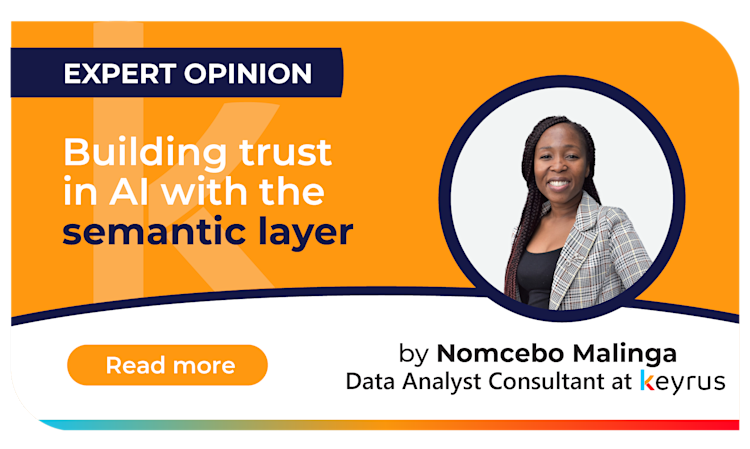In today’s fast-paced digital landscape, businesses are increasingly turning to artificial intelligence (AI) to improve decision-making, drive productivity, and extract rapid, meaningful insights. Yet, many organisations make a critical mistake during AI implementation: dumping vast volumes of raw, unstructured data into AI systems and expecting transformative intelligence in return.
This “data lake dumping” approach—training AI without structure, business logic, or data governance—often yields vague or misleading results. Without context, AI lacks the semantic understanding to generate insights that align with enterprise objectives. That’s where implementing a semantic layer becomes essential.
What Is a Semantic Layer?
The semantic layer—a foundational concept in business intelligence (BI)—is now more vital than ever in the AI era. It acts as a structured interface between enterprise data and the end user, translating technical data into business-relevant intelligence. By integrating dimensions, metrics, and business rules, the semantic layer supports consistent understanding and communication across tools and departments.
As AI becomes increasingly embedded in analytics tools—such as Microsoft Copilot, Tableau Pulse, or Google’s Looker—semantic capabilities ensure these tools are powered by contextually accurate, curated data. This elevates AI from a black-box output generator to a trustworthy source of insight.
Why You Need a Semantic Layer for AI and BI
The success of AI isn’t about feeding it more data; it’s about feeding it better, governed data. A universal semantic layer acts as the connective tissue between AI and the business language. Whether the user queries a dashboard or a chatbot, the semantic layer ensures AI understands terms like “Q1 revenue growth in North America” based on shared business definitions—not just keyword matches.
This improves data consistency, removes guesswork, and allows AI to function more like a domain expert than a statistical engine.
Building a Semantic Layer in the Modern Data Stack
In the modern data environment, characterised by data warehouses, data lakes, and diverse analytical tools, the need for a semantic layer within the architecture is undeniable. Organisations must approach semantic layer implementation methodically, aligning it with enterprise goals and compliance standards.
Here are some key ways to implement a semantic layer effectively:
Semantic Modeling Language: Use standardised modeling tools to define business logic.
Data Governance Integration: Embed rules for access, security, and data lineage into the model.
Layer in the Modern Data Stack: Position the semantic model between the storage layer (e.g., data warehouse or data lake) and the consumption layer (BI, AI tools).
Types of Semantic Layers: Centralised (enterprise-wide), federated (team-based), or embedded within analytics tools.
These practices help establish an enterprise semantic layer that supports growth, innovation, and AI scalability.
Enhancing Trust Through Explainability and Governance
One of the greatest obstacles to widespread AI adoption is trust. Many executives hesitate to act on recommendations from opaque systems. By integrating a semantic layer within AI workflows, you create a traceable, explainable path from raw data to decision-making insight.
This not only aligns AI outputs with internal metrics but also satisfies the rigorous demands of regulated industries like finance and healthcare. The result? AI systems that are not only intelligent but also auditable, repeatable, and compliant.
Empowering Self-Service Analytics With a Semantic Model
AI has already made strides in democratising analytics, but without consistent definitions, decentralised access can lead to conflicting answers. A semantic layer improves data accuracy by providing a single, governed view for everyone—from data scientists to business managers.
By aligning all tools to a shared model, organisations enable self-service analytics that are both agile and accurate—avoiding costly errors and enabling fast, data-driven decisions.
Integrating the Semantic Layer in Embedded AI
As embedded AI capabilities become more common in BI tools, understanding the semantic layer becomes critical. These tools rely heavily on semantic models for automated narratives, predictive analytics, and natural language processing.
The semantic layer is no longer a legacy BI artifact—it is the key to unlocking proactive decision-making in the AI-first enterprise.
A Guide to Semantic Success in the AI Era
In a world driven by data and innovation, companies must move beyond reactive automation and toward contextual, human-centric AI. That journey starts by building a semantic layer that aligns with your enterprise data strategy.
At Keyrus, we help organisations design and implement enterprise semantic models that empower AI to deliver smarter, business-aligned outcomes. Whether you’re looking to improve data quality, adopt AI responsibly, or explore types of semantic layers for your specific needs, we’re here to guide you.
Let’s build AI systems that are reliable, explainable, and future-ready.
Contact us at sales@keyrus.co.za to begin your AI journey with confidence.
